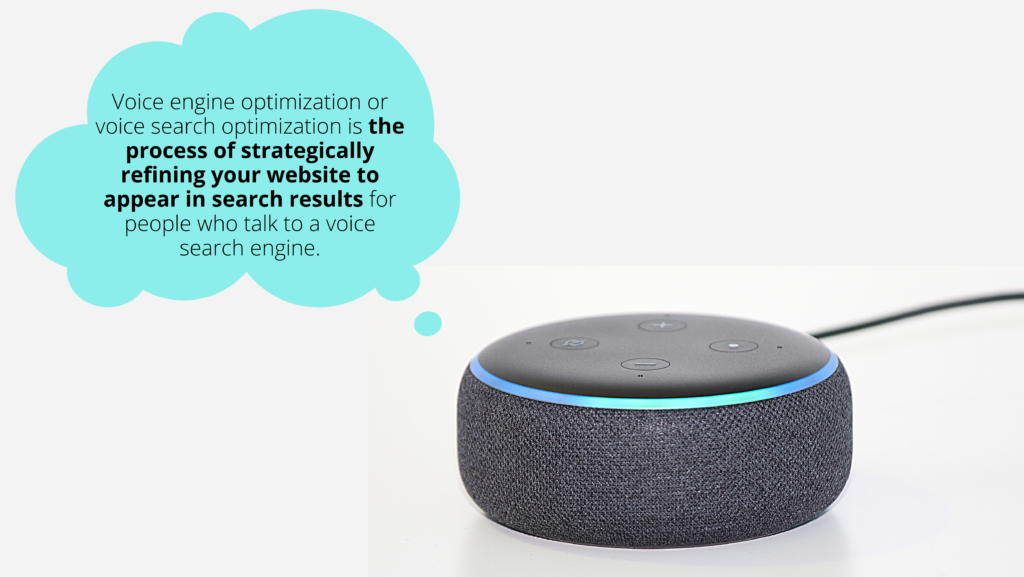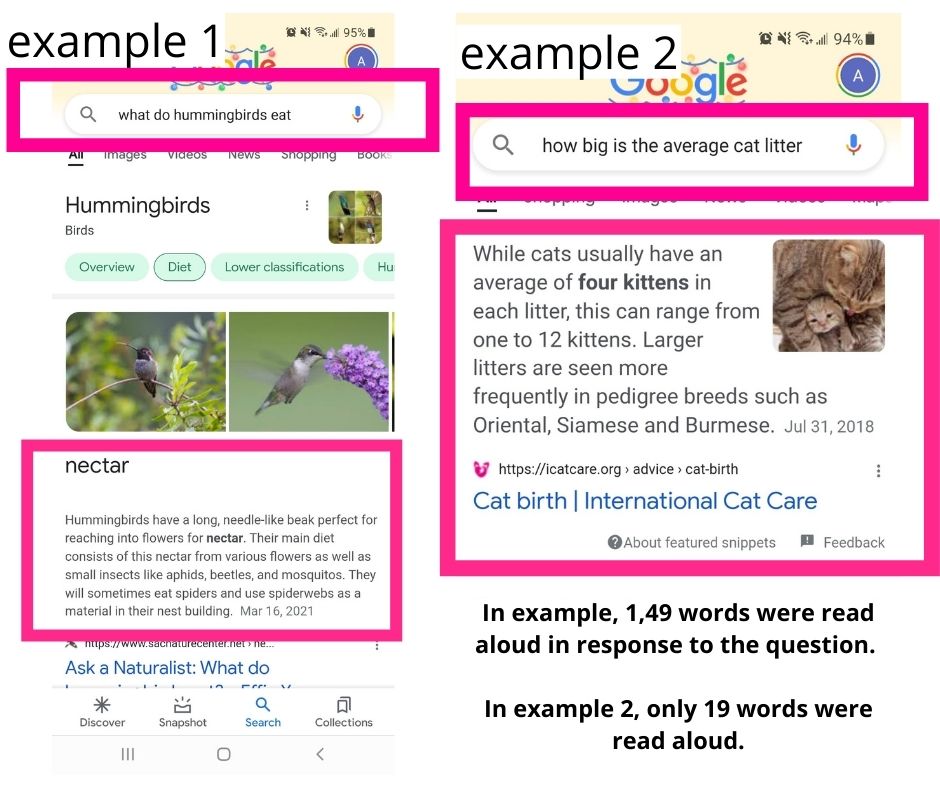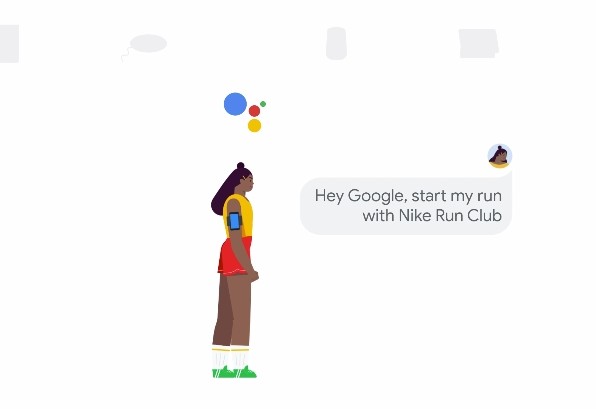Voice Search Optimization: An Updated & Comprehensive Guide
Updated 2022 Google Voice Search and voice search have changed the way people interact with search engines. Over the past few years, we’ve been able to fully […]
Updated 2022
Google Voice Search and voice search have changed the way people interact with search engines. Over the past few years, we’ve been able to fully track how this form of search has evolved and how to best optimize websites in response to how it’s used, and how algorithms prioritize their search results.
Voice searches now comprise 20% of online searches in the U.S., and the results of these searches often lead to sales. This unique technology gives website owners a new opportunity to optimize their sites to increase search engine traffic.
This article will help optimize for voice search through a better understanding of how people use this search format.
What Is Voice Engine Optimization?

Voice engine optimization or voice search optimization is the process of strategically refining your website to appear in search results for people who talk to a voice search engine. Many of the techniques for voice search optimization are similar to traditional SEO but altered to match the habits of voice searchers and voice search engine algorithms.
How Voice Search Has Change The Nature of Search

When it comes to how people use Google and other search engines, one thing is clear: voice search is here to stay. Over the past few years, more and more Americans and searchers abroad have been using voice search–and these numbers are projected to continue to increase.
The adoption of voice search is in part thanks to household smart speakers, improved hands-free driving apps, and better voice-to-text recognition technology.
2022 Trends in Voice Search
According to Inside Radio, smart speaker ownership is growing faster than any other smart technology adoption. Here’s a peek at the stats:
- Since 2018, the number of people that own a smart speaker has doubled.
- As of 2021, 33% of the U.S. population possesses a smart speaker.
- 49% of Americans that work from home own a smart speaker.
- Amazon’s Alexa far outperforms Google Home and Apple speaker devices
How Many People Use Voice Search
We understand that the ownership of smart speakers and how many people use these devices and their smartphones to search the internet are two different things. But the numbers still add up to a huge increase in people searching via Voice Search. Here are the stats:
- Almost 50% of all consumers use voice search to research their potential purchases.
- Over $2 billion in purchases were made through voice in 2018. Experts at BusinessWire predict this figure to grow to $30 to $40 billion in 2024.
- 11% of online shoppers used Amazon Alexa to make a purchase in 2020.
What Additional Factors Are Affecting Voice Search Trends?
In 2020, consumer habits fundamentally changed. The COVID-19 pandemic forced consumers to change how they shop. Many Americans, even those with limited technology proficiency, began ordering grocery delivery and expedited their trips to stores with pick-up-in-store options. Others began shopping more strategically by making lists to reduce their time spent in stores.
All of these changes were streamlined by voice search technology.
Search Giants, like Google, are also investing heavily in voice search capabilities – leaning into natural language processing and deep learning algorithms (like BERT). As voice search responses improve, users are increasingly relying on the tool for hands-free searching while they drive, cook, and more.
Who Is and Who Isn’t Using Voice Search?

Understanding who is using voice search is vital to correctly targeting your market audience. If you’re in a niche of primary adopters, you likely want to prioritize optimizing your content for voice search.
Like most trends in technology adoptions, not all demographics are using voice search at equal rates. Unlike many trends in tech innovation, the youngest demographic isn’t the most avid user of voice search. Who is? According to PWC:
- 65% of 25 to 49-year-olds use voice search heavily
- 59% of 18 to 24-year-olds use voice search heavily
- 57% of people over 49 use voice search heavily
Does Voice Search Matter When it Comes to Driving Web Traffic?
Yes. Not optimizing for voice search is like running a race in sandals–you’d be putting yourself at a disadvantage. Why? Your competitors are likely optimizing for voice search. And if they’re not, you have a strong competitive edge.
How to Optimize for Voice Search
When it comes to optimizing for voice search (VSEO), many of the same principles of SEO apply and many do not. Knowing where and how to alter your approach are key to voice search SERP success.
1. Optimize for Bing in Addition to Google

When it comes to traditional search, Google continues to be the reigning champion. However, when it comes to voice search most people using a home smart speaker use Alexa–and Alexa uses Bing. Ideally, you want to keep in mind that the majority of smartphone voice searches still rely on Google. However, optimizing for Bing can give you a more competitive edge in the realm of voice search.
How to Optimize for Bing
Like Google, Bing offers site owners a range of free analytics tools. Checking your numbers often and analyzing organic traffic patterns will provide you with priceless insight into how to rank on Bing.
Additionally, many SEO best practices still apply when tailoring your content for Bing. Bing tends to favor domains with longevity, sites that have more backlinks from social media, and user-friendly interfaces.
2. Target Conversational Keywords and Questions
Something unique happens when a person begins interacting with a voice search interface. They use conversational speech patterns, including the use of full questions and natural sentences instead of truncated search terms.
While traditional organic search queries usually consist of phrases such as “seattle thai food restaurants,” voice search queries are typically complete questions. For example, a voice searcher is more likely to search “What is the best Thai food restaurant in Seattle?”
How to Optimize for Questions and Conversational Phrasing
When selecting keywords, you will want to shift your approach slightly. To do so:
- Pay special attention to the Questions section of your SEO content assistant tool.

- Perform your own research using search engines. Google’s or Bing’s “People also ask” features can give you great insight into questions related to search queries people use to find your website.
An example of Google’s People Also Ask feature:

An example of Bing’s People Also Ask feature:

3. Target long-tail keywords which mimic conversational speech patterns better than short-tail keywords. For example, targeting “shoes that support high arches” rather than “arch support shoes” will likely result in more voice search traffic.
To find long-tail keywords, use the Keyword Research tool’s list of autocomplete search query terms or suggested terms. Pick out search terms with 3+ words.

4. Create an FAQ to capture more questions. FAQs not only provide answers to what searchers want to know, but they also present a great opportunity for you to use schema and include more questions into your content. Remember to use FAQ schema when doing so.
3. Keep Answers to Common Search Queries Concise

In addition to targeting questions and long-tail keywords, providing a direct, concise, clear answer to these queries makes your page more likely to appear in voice SERPs. On average, voice search’s audio responses are 29 words. This means you should try to keep your answers between 15 and 50 words.
4. Focus on Optimizing for the #1 SERP Position

For traditional internet searches, landing in the top 10 search results is great because users can easily scroll down to explore their options. However, because voice search results are presented first by being read back by the virtual assistant, you ideally want your page to be the top result.
75% of the time Google will pull its answer from one of the pages that appears in the top 3 SERP results.
While virtual assistants will only read the answer presented on the page in position one of the SERPs, some mobile users have the option to scroll, but rarely do they scroll beyond position 3.
How to Optimize for Position #1 in Voice Searches
The easiest way to be a contender for the top SERP position is to garner for a spot as the featured snippet. To do this, you want to employ schema markup.
Schema markup helps Google’s algorithms (and other search engines) better organize the type of content your page offers in its index. The information in the schema allows Google to use your content to populate rich snippets. Schema.org is a great resource for finding which markup is best for your content.
The Search Atlas Schema Creator also allows users to create schema without the need to be familiar with markup languages.

One of the biggest benefits of schema is that it allows you to target mobile users that often use voice searches to locate and discover businesses. Schema tells the search engine where your business is located, making it discoverable for local business searches’ since they’re geospatially relevant.
5. Be Sure Your Site Is Mobile-Friendly
If you have yet to optimize your site for mobile SEO, make it a priority. Not only does more search traffic come from mobile searches, but the majority of voice searches are performed on smartphones.
When improving your site’s mobile-friendliness, focus on:
- Page load speed (especially for content above the fold)
- Responsive web design
- Reducing layout shifts
To test your site’s mobile-friendliness, you can use PageSpeed Insights or the Lighthouse tool in your Inspection Element menu.

6. Turn Queries into Actions

Google Actions are user-developed applets that enhance the usability of Google Assistant.
They can be everything from using voice commands to send money to another person to full conversations with the Assistant.
While users can build Actions from scratch, it’s best to leverage items that already exist on your website so Actions simply make your content more engaging.
Instead of creating an Action just for the sake of it, try using the Actions on Google to find existing Actions and markup you’ve already initiated on your site and let Google do the rest. If you’ve got a how-to blog post, for example, and you use the how-to structured data, Google automatically uses that Action to read out step-by-step instructions.
This way, you get the extra engagement of Google Actions without having to take extra steps.
7. Create Content That Reflects Your Audience’s Journey & Search Intent
Understanding your audience is always vital to ranking. And this is no different when it comes to voice search SEO. Knowing your searchers’ intent and guiding your buyer persona through your sales funnel can help you be discovered by a wider range of voice searches.
Keep in mind that on average, most shoppers will read 2 to 3 articles while researching before they purchase a product or book a service.
Your website should have content to speak to all of these stages to capitalize on voice search:

- Awareness: The buyer realizes they have a problem that needs a solution, such as a broken phone screen. Ex: “Can I fix a broken iPhone screen?”
- Interest: The buyer has identified their problem and is beginning to look for solutions. Ex: “Can I fix my iPhone screen myself?”
- Evaluation: The buyer is looking to compare and contrast two or more options for a solution. Ex: “Is it better to take a broken iPhone to the Apple store or a different repair place?”
- Purchase: Questions specifically regarding the buying process. Ex: “How much does it cost to repair an iPhone?”
There are three main types of content your website needs to help you capture buyers at all stages:
- Informational content: Guides, how-tos, etc.
- Navigational content: Store hours, directions, services, press releases, contact information, etc.
- Transactional content: In-depth product guides, comparisons, product stories, videos, etc.
Making Google Voice Search Work for You
Voice Search SEO does take some extra work and requires a heavy focus on getting into snippets, but the good news is that if your site ranks for more voice searches, it’s going to rank for snippets and organic search, as well. Begin your keyword research with an eye for how people interact with their voice search devices and focus on concise answers.














































































